The Recovery Gear I Carry Overlanding
This article originally appeared on Outside
I write this via Starlink satellite Internet, from a remote alpine meadow in Montana, 25 miles from the nearest paved road. Being able to visit special places like this is the reason I enjoy off-road travel (nee overlanding), but doing so also means accepting risk and preparing for stuff to go wrong. What happens if I get stuck? Here's the gear I carry to ensure I'll always get out, how it works, and what you need to know to use it safely.
What's Recovery Gear?
Recovery is the act of getting a stuck vehicle unstuck. Recovery gear also has the ability to turn otherwise impassable terrain into something passable.
Recovering a stuck truck requires hard work and strong problem-solving skills, and it can put you in danger. That's why I carry such a generous selection of tools, make sure they're good quality, and keep them in good condition. That way, I have an arsenal of solutions I can employ whether I'm alone or need to help another vehicle.
When I bought my new Ford Ranger last year, I replaced a bunch of old, worn-out stuff in my kit. I found it easiest just to do that by placing a single order with Gear America, which makes good quality recovery gear at affordable prices, and makes some of its products here in the United States. Other reliable brands include Crosby, Factor55, Maxtrax, and ARB.
In the top image, starting top and working clockwise, you can see a set of Maxtrax MkII recovery boards, a tree saver strap, two hitch receiver recovery points (one with a shackle), a recovery rope, a winch pulley, two 3/4-inch shackles, a static strap, and two soft shackles. Here's how to use it all.
Video loading...
The Recovery Gear You Need to Carry
Maxtrax
What they're for: Maxtrax recovery boards are the originals, and made from a propriety blend of fibrous nylon, they're still the longest lasting ones out there. They're also the safest, easiest ways to resolve simple traction problems.
When to use them: If you're stuck in mud, sand, snow, or anything else slippery, Maxtrax should be the first tool you try. They're easier, faster, and far safer than any method that requires tension.
How to use them: Just shove them under your tires, then slowly drive out of the obstacle. You can also use the same method to reduce forces while winching or snatching. If the mud pit, snow drift, loose sand, or whatever else extends farther than a single pair will get you, you can just keep repeating the process. Or if you're with a group of drivers who all have a pair, build a rudimentary track with them.
Who should carry them: Everyone. These are affordable insurance against getting stuck in any circumstance. Consider Maxtrax Minis if you drive a small crossover, like a Subaru Crosstrek, or are otherwise short on space.
Tree Saver
What it's for: With a short static strap (this one's eight feet long), you can use a tree saver to wrap the trunk of a large tree, then use the loops on the end to connect a shackle or pulley. You'll use a tree as an anchor point without stripping its bark or otherwise damaging it. You can also use a tree saver to form a bridle between two recovery points on one end of your vehicle.
When to use it: Try a tree saver anytime you use a tree as a recovery point. They can also wrap other objects like boulders, axles, or frames, but obviously be careful that you don't pull on anything that might give way. Creating a bridle between two recovery points on your vehicle can help increase safety by distributing loads between your frame rails.
Who should carry it: Anyone with a winch.
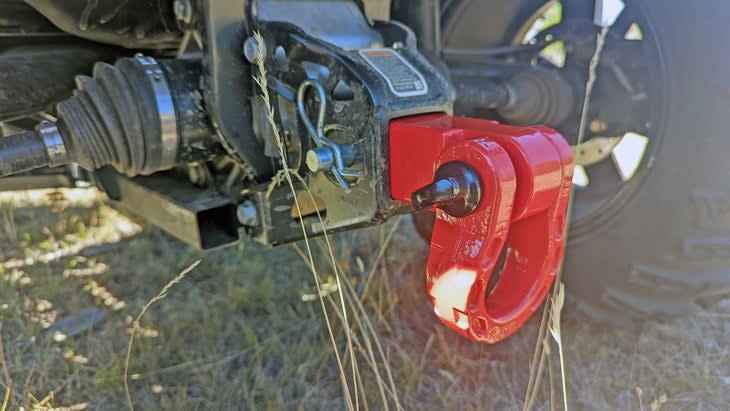
Hitch Receiver Recovery Points
What they're for: You insert these in a two-inch tow hitch receiver to create a safe place to attach a hard or soft shackle.
When to use them: While you can simply insert a hitch pin through the loop on a kinetic strap, doing so puts that pin in sheer, meaning you risk bending it inside the receiver. These blocks of aluminum support the entire length of the pin, so it won't have the opportunity to bend.
How to use them: If you need to drive forward while pulling another vehicle, these give you a safe place from which to attach a kinetic strap. If a vehicle needs to be pulled rearwards, they do the same. I carry two in case I need to help, or get help from, someone who's not carrying one. Make sure you carry hitch pins for them, too.
Who should carry them: Anyone with a two-inch tow receiver. If you travel off-road, you should equip your vehicle with that receiver. The easiest, cheapest place to get one is UHaul.
Video loading...
Recovery Rope
What it's for: Think of these as big elastic bands. The elasticity helps lower momentary forces and pull one vehicle out of an obstacle with another.
When to use it: If your Maxtrax aren't enough to get out of something, this is the next solution you should try.
How to use them: Connect the rope to the vehicle being rescued using a shackle and an appropriate recovery point. That'll be the Hitch Receiver Recovery Point, or purpose-made recovery points mounted underneath your front frame rails. Never attempt to perform a recovery by pulling on the little screw-in tow eyelets on passenger cars. Do the same on the vehicle performing the recovery, then drive forwards slowly (no more than five miles per hour), until you feel the rope begin to stretch. Keep driving forwards slowly, and you should feel the rope begin to shorten as it pulls the vehicle behind you out of the obstacle.
Who should carry them: You'll also see these called kinetic ropes, and you'll see kinetic straps sold for the same purpose. A rope will retain its elasticity through more pulls than straps before requiring a rest period to regain its elasticity, but ropes typically cost more. Anyone going off-road should carry a kinetic rope or strap. Drivers who expect to perform more, or more difficult recoveries, will be better served by the rope.
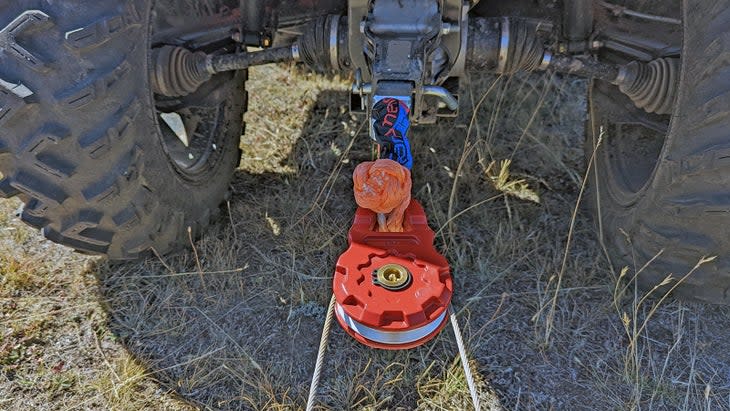
Winch Pulley
What it's for: A winch pulley allows you to change the angle of a winch line or increase the force applied by that device.
When to use it: Winches aren't able to achieve their advertised strength unless you get most of the winch line unspooled from the drum. And, using a pulley to double the line back to the vehicle doubles the force a winch can apply. So even if you're only winching in a straight line for a short distance, using a pulley will help your winch work better. If you can't rig a straight pull, a pulley may also help you pull around a corner.
How to use them: If you're pulling in a straight line, just pass the winch line around the pulley, then connect the pulley to a tree strap or vehicle using a shackle, and continue to run the line back to your own recovery point. If you're trying to pull at an angle, follow the same instructions, but set up the pulley on the far side of the corner you're trying to reach around. Some challenging pulls can require re-rigging your pulley multiple times to change angles slowly.
Who should carry them: Anyone with a winch should carry at least one pulley. People participating in recreational off-road travel through extremely challenging terrain should consider carrying multiple pulleys. You'll need at least three, for example, if you hope to use a front-mounted winch to pull your vehicle rearwards.
3/4-inch Shackles
What they're for: 3/4-inch shackles connect a strap, rope, or winch line to a vehicle's recovery point, or to a tree saver.
When to use them: Hard shackles like these are incredibly strong. These Gear America Mega Shackles, for instance, are tested to deliver a minimum breaking strength of at least 68,000 pounds. They're also impervious to abrasion, and cuts. That means you can use them to connect to any recover point with an internal diameter of at least 7/8ths of an inch.
How to use them: Using one heavy vehicle to pull on another one, or using a winch, can create enormously high momentary forces. That can actually stretch these steel shackles, trapping the pins in place. Because of that, many people tighten the pin fully, then back it off a quarter turn, but doing so actually lowers the breaking strength of the shackle. Always tighten the pins fully, and use an adjustable wrench to loosen them afterwards if necessary. Avoid side loading a shackle; its pin should always run perpendicularly across the direction of a pull.
Who should carry them: Anyone carrying a kinetic strap or rope should also carry at least two shackles. Unless you have appropriate equipment designed to interface with soft shackles, these are the better option. If you might ever need to connect to a strange vehicle that may not be equipped with soft shackle-appropriate points, you'll need 3/4-inch shackles, too. These are the appropriate size for all non-commercial vehicles. If a point on your vehicle is too small to accept the pin from one of these, then it's not strong enough to be used in a recovery.
Static Strap
What they're for: Also called a tow rope, you can use these to tow a disabled vehicle once you've used that kinetic strap or rope to pull it out of an obstacle. Because they don't stretch, you can also them them to extend a winch line.
When to use them: Never use a static strap in place of a kinetic strap or rope. They don't stretch and can therefore amplify the momentary loads trying to haul a vehicle out of sticky mud or similar creates. But you can use a static line to extend the reach of a winch line.
How to use them: Break your vehicle off-road? Use a tow strap to connect it to another vehicle with your shackles, and tow it home. Should you need to extend the length of a kinetic rope or strap, simply thread one end of each through one loop of each (as you'd attach a fly line to your tippet), to connect them.
Who should carry them: Prioritize carrying a kinetic rope or strap if you're short on budget or space. Those work fine as tow ropes, too, even if employing one in that role risks damaging that more expensive tool. If you have a winch, it's unsafe to employ any elastic component during a pull. So if you think you'll ever need more length than your winch line offers, you'll need a static strap to extend it.
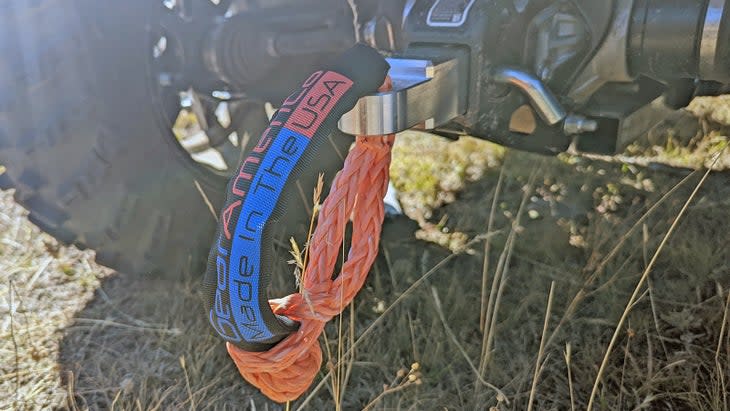
Soft Shackles
What they're for: Should any component used in a recovery break, you risk sending stuff flying around at lethal speeds. Anything made from metal will kill you if that happens. Something made from soft, synthetic fibers will probably only wound you. Soft shackles may therefore be the safer option in some very specific circumstances, even if their minimum breaking strength is far lower than hard shackles.
When to use them: Soft shackles can be damaged by abrasion or cut by sharp edges. So you first need recovery points designed to interface with soft shackles before you can safely use them. Soft shackles can also be damaged if they're bent at too tight of an angle while pulling, so don't try to use them on your vehicle's factory recovery points, even if those appear nice and round.
How to use them: Push the loose end of the soft shackle through the hole in a designed-for-purpose recovery point, though the loop on a strap or rope, then push the monkey fist knot tied on the other end through the loop on the loose end, and pull that loop tight.
Who should carry them: Only drivers equipped with recovery points designed for soft shackles should use them. And, even then, you should consider also carrying hard shackles so you can interface with other vehicles. Used correctly, recovery gear in good condition should never break, so the additional safety promised by soft shackles shouldn't be necessary.
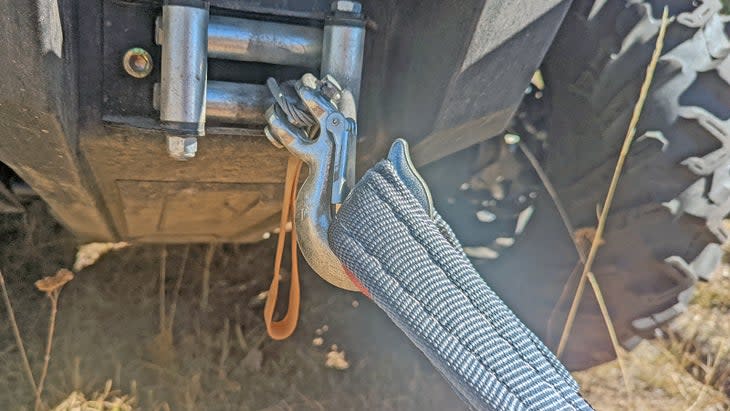
Winch
What it's for: A winch is an extremely powerful tool designed to pull heavy objects.
When to use them: Turn to these when nothing else will work.
How to use them: Anyone hoping to use a winch should first take an in-person winching class. Most 4×4 schools, and some first responder training organizations offer these.
Who should carry them: Anyone traveling alone through remote areas off-road should be equipped with a winch (and the knowledge to use them correctly), as should anyone attempting very challenging terrain.
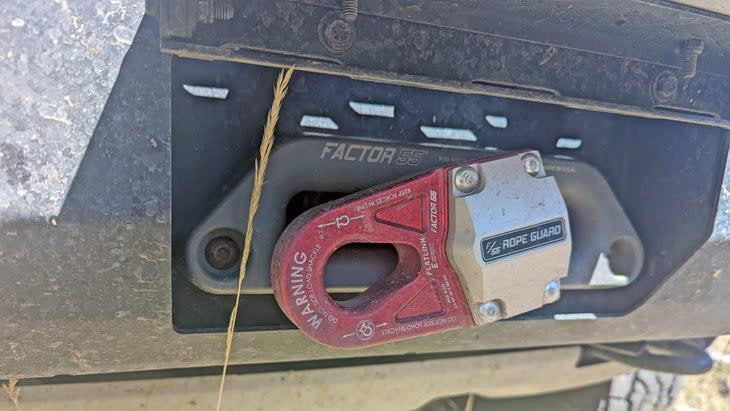
Winch Shackle Mount
What it's for: A winch shackle mount connects the winch line to a shackle safely.
When to use them: A lot of winch technology comes from the industrial rigging industry (think: cranes), and isn't actually designed to work on vehicles. For example: the hooks that come with most winches are designed to connect to chains, not shackles or straps, and are incapable of achieving total safety with the latter. Conversely, a proper shackle mount will be designed to entirely retain a hard or soft shackle, or as is the case with this one, both.
How to use them: It takes about ten seconds and a pair of snap ring pliers to swap the unsuitable, unsafe hook for a closed-loop shackle mount, like this Factor55 Flatlink E.
Who should carry them: Anyone mounting a winch to their vehicle should spend the extra money on a purpose-built shackle mount.
For exclusive access to all of our fitness, gear, adventure, and travel stories, plus discounts on trips, events, and gear, sign up for Outside+ today.

